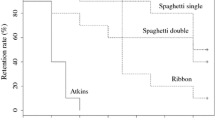Abstract
Self-feeding device is extensively used in aquaculture farms, but for salmonids the individual feeding behavior has seldom been continuously observed. In this article, the individual self-feeding behavior of 10 rainbow trout was continuously monitored with a PIT tag record for 50 days with three replicates. The fish fell into three categories according to their feeding behavior, i.e. high triggering fish (trigger behavior more than 25% of the group, HT), low triggering fish (1%–25%, LT) and zero triggering fish (less than 1%). The results showed that in a group of 10 individual 1–2 HT fish accounted for most of the self-feeding behavior (78.19%–89.14%), which was far more than they could consume. The trigger frequency of the fish was significantly correlated with the initial body weight (P <0.01), however, no significant difference in growth rate among the HT, LT, and ZT fish was observed (P >0.05). Cosinor analysis showed that the two HT fish in the same group had similar acrophase. Though some of the HT fish could be active for 50 d, there were also HT fish decreased triggering behavior around 40 d and the high trigger status was then replaced by other fish, which was first discovered in salimonds. Interestingly, the growth of the group was not affected by the alternation triggering fish. These results provide evidence that in the self-feeding system the HT fish didn’t gain much advantage by their frequent self-feeding behavior, and high trigger status of the HT fish is not only an individual character but also driven by the demand of the group. In the self-feeding system, the critical individual should be closely monitored.
Similar content being viewed by others
References
Alanärä A, Brännäs E. 1996. Dominance in demand–feeding behaviour in Arctic charr and rainbow trout: the effect of stocking density. Journal of Fish Biology, 48 (2): 242–254.
Attia J, Millot S, Di–Poï C, Bégout M L, Noble C, Sanchez–Vazquez F J, Terova G, Saroglia M, Damsgård B. 2012. Demand feeding and welfare in farmed fish. Fish Physiology and Biochemistry, 38 (1): 107–118.
Brown J L. 1964. The evolution of diversity in avian territorial systems. The Wilson Bulletin, 76 (2): 160–169.
Bureau D P, Hua K, Cho C Y. 2006. Effect of feeding level on growth and nutrient deposition in rainbow trout (Oncorhynchus mykiss Walbaum) growing from 150 to 600. Aquaculture Research, 37 (11): 1 090–1 098.
Chen W M, Naruse M, Tabata M. 2002. Circadian rhythms and individual variability of self–feeding activity in groups of rainbow trout Oncorhynchus mykiss (Walbaum). Aquaculture Research, 33 (7): 491–500.
Covès D, Beauchaud M, Attia J, Dutto G, Bouchut C, Bégout M L. 2006. Long–term monitoring of individual fish triggering activity on a self–feeding system: an example using European sea bass (Dicentrarchus labrax ). Aquaculture, 253 (1–4): 385–392.
Cubitt K F, Winberg S, Huntingford F A, Kadri S, Crampton V O, Øverli Ø. 2008. Social hierarchies, growth and brain serotonin metabolism in Atlantic salmon (Salmo salar ) kept under commercial rearing conditions. Physiology & Behavior, 94 (4): 529–535.
Di–Poï C, Attia J, Bouchut C, Dutto G, Covès D, Beauchaud M. 2007. Behavioral and neurophysiological responses of European sea bass groups reared under food constraint. Physiology & Behavior, 90 (4): 559–566.
Di–Poi C, Beauchaud M, Bouchut C, Dutto G, Covès D, Attia J. 2008. Effects of high food–demand fish removal in groups of juvenile sea bass (Dicentrarchus labrax ). Canadian Journal of Zoology, 86 (9): 1 015–1 023.
Ferrari S, Benhaïm D, Colchen T, Chatain B, Bégout M L. 2014. First links between self–feeding behaviour and personality traits in European seabass, Dicentrarchus labrax. Applied Animal Behaviour Science, 161: 131–141.
Heydarnejad M S, Purser J. 2013. Demand–feeding activity of rainbow trout (Oncorhynchus mykiss ) in Raceways. World Journal of Zoology, 8 (1): 36–46.
Jobling M. 1995. Simple indices for the assessment of the influences of social environment on growth performance, exemplified by studies on Arctic charr. Aquaculture International, 3 (1): 60–65.
Millot S, Bégout M L, Person–Le Ruyet J, Breuil G, Di–Poï C, Fievet J, Pineau P, Roué M, Sévère A. 2008. Feed demand behavior in sea bass juveniles: Effects on individual specific growth rate variation and health (inter–individual and inter–group variation). Aquaculture, 274 (1): 87–95.
Millot S, Bégout M L. 2009. Individual fish rhythm directs group feeding: a case study with sea bass juveniles (Dicentrarchus labrax ) under self–demand feeding conditions. Aquatic Living Resources, 22 (3): 363–370.
Millot S, Nilsson J, Fosseidengen J E, Bégout M L, Fernö A, Braithwaite V A, Kristiansen T S. 2014. Innovative behaviour in fish: Atlantic cod can learn to use an external tag to manipulate a self–feeder. Animal Cognition, 17 (3): 779–785.
Refinetti R, Cornélissen G, Halberg F. 2007. Procedures for numerical analysis of circadian rhythms. Biological Rhythm Research, 38 (4): 275–325.
Sunuma T, Amano M, Yamanome T, Yamamori K. 2009. Individual variability of self–feeding activity in groupreared barfin flounder. Fisheries Science, 75 (5): 1 295–1 300.
Acknowledgement
We are grateful to the anonymous reviewers for their professional revision of the manuscript.
Author information
Authors and Affiliations
Corresponding author
Additional information
Supported by the National Natural Science Foundation of China (No. 31602208), the K. C. Wong Magna Fund in Ningbo University, and the Qingdao Post-doctoral Application Research Project (No. Y6KY01110N)
Rights and permissions
About this article
Cite this article
Shi, C., Gao, X., Liu, Y. et al. Long-term monitoring of the individual self-feeding behavior of rainbow trout Oncorhynchus mykiss. J. Ocean. Limnol. 37, 344–349 (2019). https://doi.org/10.1007/s00343-019-8020-5
Received:
Accepted:
Published:
Issue Date:
DOI: https://doi.org/10.1007/s00343-019-8020-5




